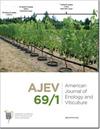选择性非酵母菌在冷浸过程中对羊粪菌生长的影响
IF 1.8
3区 农林科学
Q3 BIOTECHNOLOGY & APPLIED MICROBIOLOGY
引用次数: 8
摘要
本试验研究了选定的非酵母菌菌株在冷浸发酵过程中对鹿茸菌生长及乙酸和乙酸乙酯产量的影响。我们测试了市售的非酵母菌酵母菌在葡萄汁培养基中模拟冷浸过程中减少吸血弧菌生长和醋酸产生的能力。所有测试的非酵母菌酵母菌都减少了吸血嗜血杆菌的生长和醋酸的产生,其中一些酵母菌的影响比其他酵母菌更大。在对非酵母菌进行筛选之后,我们对14种不同的uvarum分离株与选定的非酵母菌——果霉Metschnikowia fructicola进行了测试,发现所有的uvarum分离株与果霉m.s ucticola共培养时,生长和乙酸产量都有所下降,并注意到不同分离株之间的差异。最后,我们评价了在黑皮诺葡萄优先冷浸过程中,果霉菌对uvarum菌的影响。用uvarum和m.s ucticola组合接种黑皮诺葡萄,在8°C下冷浸6天。在冷浸泡结束时,接种果霉处理的uvarum种群数量和乙酸、乙酸乙酯浓度显著低于未接种果霉处理。在酒精发酵完成后,加入果霉的葡萄酒中乙酸乙酯含量显著降低,但乙酸浓度没有差异。这些结果表明,添加精选的非酵母菌可能是另一种方法,以减少在优选冷浸泡期间被uvarum变质的风险。本文章由计算机程序翻译,如有差异,请以英文原文为准。
Influence of Select Non-Saccharomyces Yeast on Hanseniaspora uvarum Growth during Prefermentation Cold Maceration
This study investigated the effect of select non-Saccharomyces yeast strains on Hanseniaspora uvarum growth and acetic acid and ethyl acetate production during prefermentation cold soak. We tested commercially available non-Saccharomyces yeasts for their ability to reduce H. uvarum growth and acetic acid production during a simulated cold soak in a grape juice-based medium. All tested non-Saccharomyces yeast reduced H. uvarum growth and acetic acid production, with some yeast having a greater impact than others. Following the screening of non-Saccharomyces yeast, we tested 14 different H. uvarum isolates against a selected non-Saccharomyces yeast, Metschnikowia fructicola, and found that all H. uvarum isolates had reduced growth and acetic acid production when grown in co-culture with M. fructicola, with variation between isolates noted. Finally, we evaluated the effect of M. fructicola on H. uvarum during prefermentation cold soak of Pinot noir grapes. Pinot noir grapes were inoculated with a combination of H. uvarum and M. fructicola and cold soaked for six days at 8°C. At the end of cold soaking, treatments inoculated with M. fructicola contained lower populations of H. uvarum and significantly lower acetic acid and ethyl acetate concentrations compared with treatments not inoculated with M. fructicola. After the completion of alcoholic fermentation, wines where M. fructicola was added contained significantly lower ethyl acetate but no differences in acetic acid concentration. These results suggest that adding select non-Saccharomyces yeast may be another method to reduce the risk of spoilage by H. uvarum during prefermentation cold soaking.
求助全文
通过发布文献求助,成功后即可免费获取论文全文。
去求助
来源期刊

American Journal of Enology and Viticulture
农林科学-生物工程与应用微生物
CiteScore
3.80
自引率
10.50%
发文量
27
审稿时长
12-24 weeks
期刊介绍:
The American Journal of Enology and Viticulture (AJEV), published quarterly, is an official journal of the American Society for Enology and Viticulture (ASEV) and is the premier journal in the English language dedicated to scientific research on winemaking and grapegrowing. AJEV publishes full-length research papers, literature reviews, research notes, and technical briefs on various aspects of enology and viticulture, including wine chemistry, sensory science, process engineering, wine quality assessments, microbiology, methods development, plant pathogenesis, diseases and pests of grape, rootstock and clonal evaluation, effect of field practices, and grape genetics and breeding. All papers are peer reviewed, and authorship of papers is not limited to members of ASEV. The science editor, along with the viticulture, enology, and associate editors, are drawn from academic and research institutions worldwide and guide the content of the Journal.
 求助内容:
求助内容: 应助结果提醒方式:
应助结果提醒方式:


